Zucchinis are prolific growers. You will see the vines taking over your garden within a few weeks. But they are still prone to potential problems, and today’s article is about their issues and solutions.
Several problems can affect the Zucchini growth, for example, seeds not germinating, curly or yellow leaves, wilted leaves, fruits mottled or distorted, fruits rotting at the base, stunted growth, flowers falling off, no fruit production, gummy or weak stems, and many more.
Are you facing problems with your Zucchini plant but unable to identify and fix them? Then this article is all you need. Here, we will share all the possible problems a Zucchini will face while growing and how you can troubleshoot them. So, let’s begin without further delay.
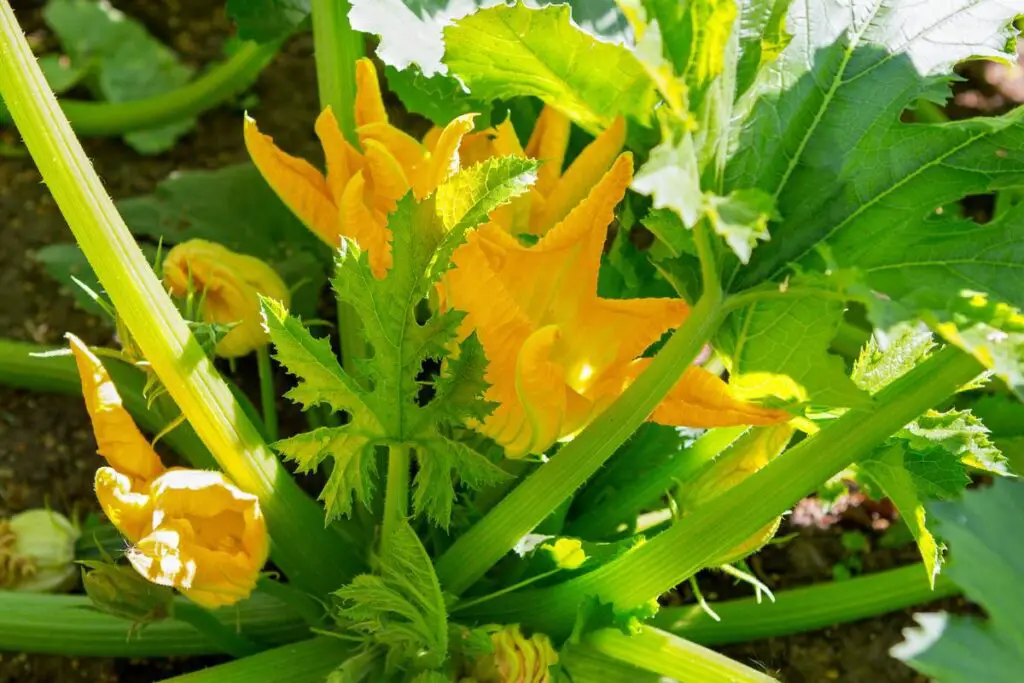
1. Yellowing Leaves
I have grown Zucchinis for a long time.
I have faced many issues throughout the journey, and yellowing is one of the most common things I have observed.
I have seen yellowing on my Zucchini plant’s leaves numerous times, but the reasons differed each time.
There are several reasons for yellow leaves, and here I am sharing a few possible causes that turned my Zucchini leaves yellow:
Lack of sunlight
Zucchinis love sunlight. They need at least 6 to 8 hours of direct sunlight daily for optimal growth and higher yields.
Enough sunlight encourages the production of chlorophyll responsible for pigmentation.
Lack of sunlight can lead to chlorosis or yellowing, where the leaves cannot receive enough pigment.
Prevention is the best solution here. Before planting, find a place with enough sunlight.
Some of my plants were in the backyard, where they couldn’t receive enough sunlight.
After some time, I noticed yellowing and understood the problem.
I used some Grow lights designed for outdoor plants to cope with the lack of light. After some time, the plant became fine.
Too much or too light water
Zucchinis also love moisture, but excessive moisture can be harmful.
Zucchinis should be watered 1-2 times weekly with one inch of water.
The frequency and amount should be increased or decreased based on the weather.
With little water, the plant cannot take enough moisture and nutrients from the soil, stop growing, and the leaves start turning yellow.
The same happens with overwatering.
Too much water suffocates the roots, for which they cannot send any moisture or nutrients to the other plant parts.
As a result, the plant shuts down and leads to yellowing.
The best way is to check the moisture level regularly and then water the plant when the top few inches have dried.
Damaged roots
When the roots are damaged, they cannot send enough moisture and nutrients to the other plant parts.
As a result, the plant will have yellow leaves.
Roots can be damaged for several reasons, for example, deep pest infestation, root rot, or physical damage.
You need to take the plant out, examine the roots, and try some troubleshooting steps, like adding insecticides and removing the damaged roots.
Reviving is difficult but possible if the damage is below 50%.
2. Curly Or Deformed Leaves
When leaves curl and distort, suspect a pest infestation.
Aphids can suck the sap of the leaves, leaving the leaves dehydrated with stunted growth patterns.
A common sign of aphid infestation is ants following them.
The aphids suck the sap and leave behind honeydew, making your leaves sticky. This further invites ants.
The first solution is to shower your plant with a blast of water.
It will dislodge the aphids from their place.
Concentrate more on the under of the leaves as that’s their home.
Try spraying with a solution of dishwashing soap and water in a ratio of 1:10. Do this for 2 weeks once a day.
Add ladybugs or green lacewings to your garden.
They will feed on these bugs.
Spray neem oil every 2-3 days for 2 weeks. If you do this, you cannot invite bugs and do it in the evening after sunset to prevent burns.
3. Seeds Not Germinating
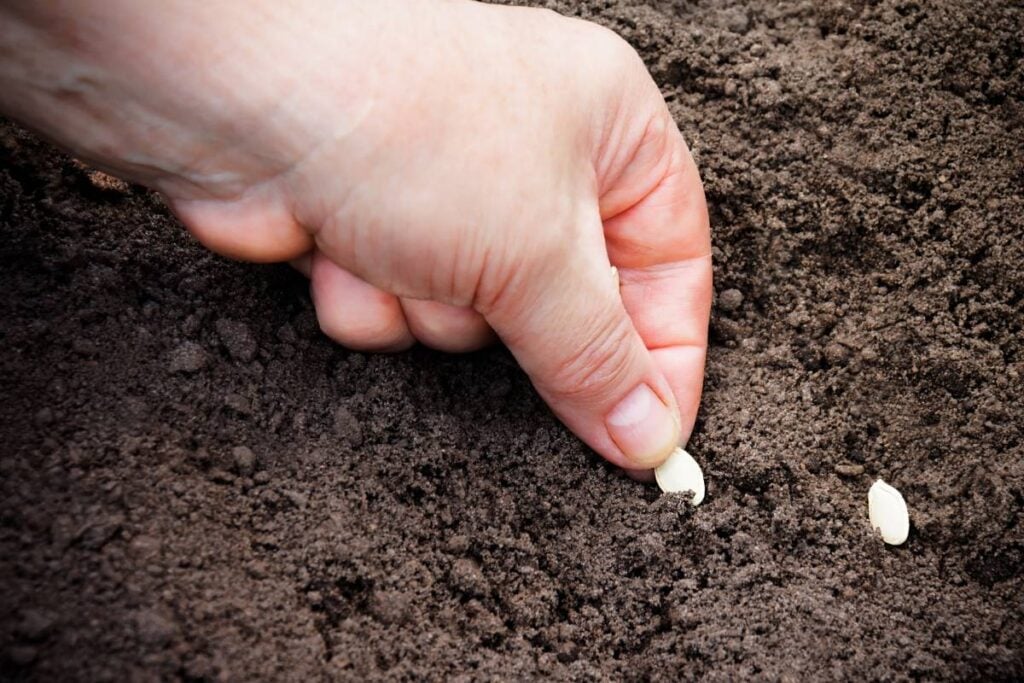
The Zucchini seeds generally sprout within 8 to 10 days.
But if your seed is not sprouting even after 2 weeks, something is wrong with the seeds.
Here are some possible reasons:
Seeds are old
The Zucchini seeds stay viable for 4 years if stored correctly.
You might not have stored them properly, or the seeds are over 4 years old.
In this case, the seeds will struggle to come out and end up without germinating.
Make sure that the Zucchini seeds are stored correctly and are recent seeds. They should not be dry or moldy.
Wash, dry, and store the seeds in an airtight container.
Keep the container in a cool, dry, and dark place.
I suggest planting the seeds within one year or buying new seeds each season.
Bad seed starting mix
While sowing the seeds, you will need a good-quality seed starting mix.
If the seed starting mix is old or you are reusing an old soil mix, the seeds will not germinate.
You can mix some garden soil with organic matter and use it as a seed starting mix or buy fresh, high-quality mix offline or online.
Mix organic matter into the soil for outdoor sowing, then sow the seeds.
Underwatering or overwatering
After sowing the seeds, keep the soil consistently moist for germination.
In dry soil, the seed cannot grow and germinate properly.
At the same time, excessive water can rot the seed.
Consider deep but infrequent watering.
The soil should stay moist, not wet. You can use a spray bottle to spray water into the soil regularly instead of directly pouring.
Ensure that the soil remains moist all the time and they receive plenty of sunlight throughout.
If the soil feels wet, do not water.
Looking for gardening supplies? We have tested 100's of products before recommending them to you guys. Check out our best pick below:
| Image | Gardening Supplies | Best Price? |
|---|---|---|
 Top
Top Top
Top | Raised Garden Bed Kit | Check On Amazon |
 | XLUX Soil Moisture Meter, Plant Water Monitor, Soil Hygrometer Sensor for Gardening, Farming, Indoor and Outdoor Plants, No Batteries Required | No Results |
 Top
Top Top
Top | 82 Pcs Garden Tools Set and Extra Succulent Tools Set | Check On Amazon |
 | Joeys Garden Expandable Garden Hose with 8 Function Hose Nozzle, Lightweight Anti-Kink Flexible Garden Hoses, Extra Strength Fabric with Double Latex Core, (50 FT, Black) | No Results |
 Top
Top Top
Top | Dual Chamber Compost Tumbler | Check On Amazon |
 Top
Top Top
Top | Sunnyglade Plant Stakes | Check On Amazon |
 Top
Top Top
Top | Organic Cold Pressed Neem Seed Oil | Check On Amazon |
 Top
Top Top
Top | Mighty Mint Gallon :-Insect and Pest Control Peppermint Oil | Check On Amazon |
 Top
Top Top
Top | Scotts DiseaseEx Lawn Fungicide | Check On Amazon |
 Top
Top Top
Top | Jacks Classic 20-20-20 All Purpose Fertilizer | Check On Amazon |
 Top
Top Top
Top | 30,000 Seeds Pollinator Attracting Wildflower Mixture | Check On Amazon |
 Top
Top Top
Top | Survival Vegetable Seeds Garden Kit-Over 16,000 Seeds | Check On Amazon |
Cold weather
The right time to direct sow the Zucchini is when the soil temperature rises above 60°F and the air temperature is above 65-70°F.
If you have planted the seeds when the temperature is still cold, it won’t germinate. Cold weather makes the seed sterile.
To avoid this, start the seeds indoors and transfer them outside once the temperature warms up.
Planted too deep
The Zucchini seeds should be planted 1-1.5 inches deep.
Planting too deep makes them struggle to come out of the soil.
If the seeds are not germinating, check their depth. Plant them one inch deep and not more than that.
4. Seedlings Rotting And Dying
You have managed to germinate the seeds, but now the seedlings are rotting and dying.
You will notice discolored or water-soaked seedlings.
At times, you will also see some cotton-like growth on the soil.
What are the possible reasons? Here are some potential causes:
Damping off
The seedlings will seem healthy today but appear shriveled and die on the soil surface after 1-2 days.
The reason is the damping-off caused by fungi. You may also see white growth on the soil surface.
To avoid this, buy seeds from a reputed shop and use good-quality soil mix.
If you use old seed mix, ensure they are clean and sterile.
Avoid overwatering the seeds and maintain good airflow.
If you are growing the Zucchini indoors or in a greenhouse, you can install a fan for sufficient air circulation.
Lack of moisture
Zucchinis will need consistent moisture levels throughout their growing season.
Insufficient water and dehydration will kill the seedlings before they enter the vegetative growth stage.
Assure moisture consistency.
Water the plant whenever the top few inches have dried.
Keep the soil moist until the seedling is well-established.
The root system is extensive, so watering can help it spread as much as possible.
Do not overwater.
5. Lots of Flowers But Lack Of Fruit Production

Zucchini fruits appear from the female flowers after pollination.
If there are lots of male and female flowers but no fruit production, you have 2 potential issues:
Lack of pollination
After the female flowers appear, pollinators like bees and butterflies carry the pollen from the male flower to the female flower for pollination.
Then, the fruits will grow from the base of the female flowers.
If there are no pollinators in your garden, Zucchinis will not pollinate, and there won’t be any fruits.
Your region may have a low pollinator count, or the weather is unsupportive.
At the beginning of the season, the temperatures can vary in spring and early summer, which doesn’t attract pollinators.
But be patient. Once the warm weather stays warm consistently, there will be enough pollination.
Another solution is to hand-pollinate them.
Sending out male flowers
This is quite common.
The plant wants to grow a lot of male flowers initially to ensure there are plenty of them for pollination. Later, the female flowers appear.
However, the chances of pollination are reduced when the male flowers fall off. Do not worry, as pollination will take time in this case.
The old male flowers fall off. But the plant will again grow male flowers.
The plant tries to grow as many male flowers as possible for pollination.
Be patient and wait. You will eventually see fruit growth.
6. Flowers Falling Off The Plant
Sometimes, you will see that the flowers are falling off the plant.
Zucchini is a monoecious variety. Both male and female flowers grow in a plant.
The male flowers will pollinate the female flower to produce fruits.
If male flowers fall off, their pollen is already used for pollination.
This is very natural. So do not get disheartened.
After some time, you will see fruits at the female flowers’ base.
When a newly planted Zucchini thrives, it will produce too many male flowers for good pollination.
The ones that grow in the very beginning may fall off before pollination.
But do not worry; there will still be flowers left for pollination.
Another reason could be extreme heat.
But here, both the male and female flowers can drop off.
When the temperature crosses 100-115°F, the flowers can receive heat stress and fall off.
To prevent this, shade your plant, increase watering, and add a thick layer of mulch.
7. Holes In The Leaves
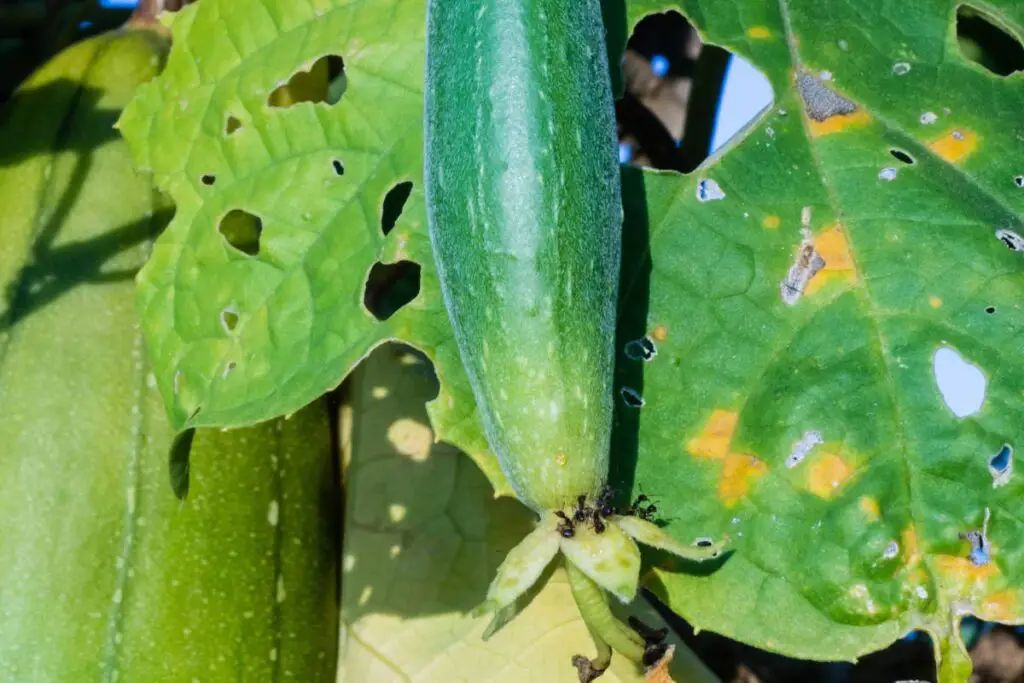
Holes in the leaves indicate that something is eating up your plant.
You will have to deal with this pest infestation as fast as possible.
Over time, the pests can eat up your whole plant.
Common pests are squash borers, cucumber beetles, and flea beetles.
They will eat and skeletonize your Zucchini leaves.
Some practical troubleshooting steps are:
- Spreading diatomaceous earth around the soil base.
- Adding sticky traps to trap the Beatles.
- Finding and spraying neem oil on the affected parts of the leaves.
- Cover the young plants with a light-row cover to keep the pests from attacking your plant further. Remove them when the plant is flowering.
8. Powdery coating on the leaves
Nothing makes such an appearance except for Powdery Mildew.
The primary culprit is too hot and humid weather and highly damp soil for prolonged periods.
Another reason is overcrowding and lack of air circulation.
Once, I planted some Zucchini in my backyard to let them spread.
There was enough space for them to spread, and I did not think of pruning.
After some days, upon checking, I found a powdery coating over the leaves. I also received a few bad fruits that year.
You must isolate the plant and spray some neem oil on the infected leaves to fix the issue. You can also use fungicides.
For prevention, maintain proper space between the plants.
Before planting them, at least 2-3 feet of distance should be considered.
9. Gummy And Weak Stems
Usually, the Zucchini stems should be firm and vibrant.
But it is alarming if there is a softness and rotten-like appearance, and it feels gummy.
Over time, these symptoms will progress to the fruits and other parts of the plant.
During a humid climate with moderate temperatures, a fungal disease called Gummy Stem Blight can attack your plant.
Fortunately, the treatment and prevention are similar to powdery mildew.
Remove the infected plant and spray some neem oil or organic bio-fungicide on the plant, like Actinovate.
To prevent the issue, clean the crop residue from the garden and keep the surroundings clean. Ensure good airflow.
10. Lumpy And Misshapen Fruits
When we start Zucchinis and care so much throughout their growing period, it is obvious to expect smooth-skinned, shiny, straight fruits.
But what if the fruits are lumpy and misshapen? The reason is the yellow mosaic virus. It is uncommon and concerning.
The virus can be present in the seeds or carried by aphid infestation.
There is no solution for this except for prevention.
Make sure to buy good-quality virus-resistant seeds and avoid aphid infestation by growing companions that deter pests or introducing ladybugs and lacewings.
If the plant is already infected, remove it and throw it away in a garbage, not a compost pile.
Start growing fresh Zucchinis, provided you still have a growing season left.
Consider crop rotation every few years.
11. Plant Is Falling Over
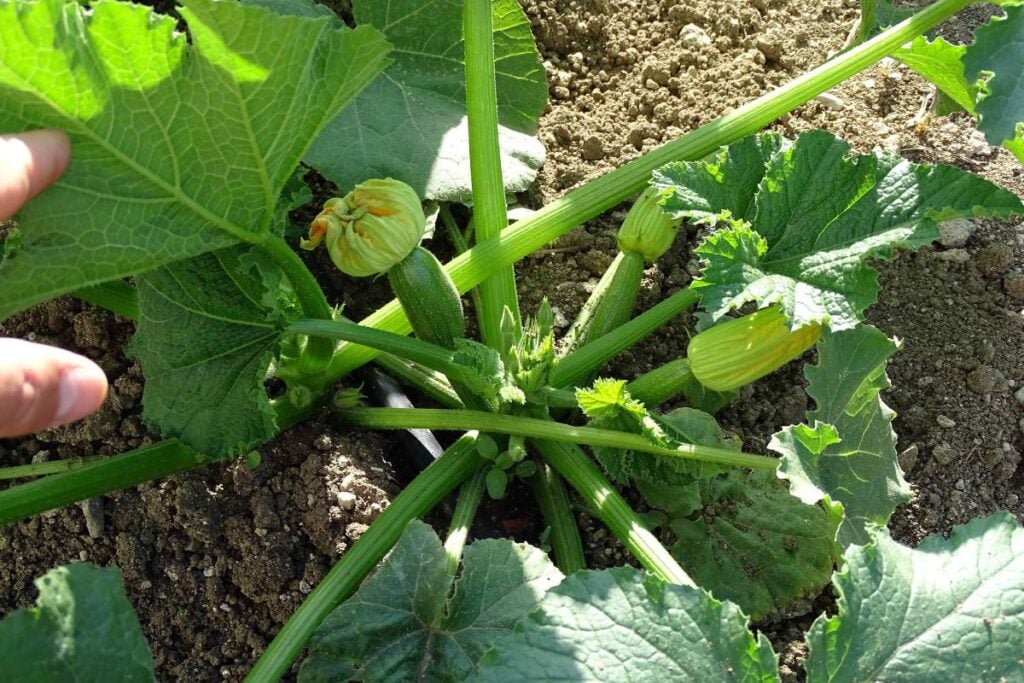
When the fruits mature, their weight can turn your plant down.
Usually, the plant is strong enough to carry the weight, but a stressful and weak plant cannot endure the fruit’s heavyweight.
Droughts, lack of nutrients, or infection weakens the stems and makes them soft, making the plant unable to carry the weight.
If you suspect drought, check for wilted leaves or dry soil.
Water the plant deeply and wait for some time.
Feed your plant every 2-3 weeks with a balanced fertilizer once it enters vegetative growth.
Find the infection and treat it accordingly.
Use stakes or a trellis to provide support to your Zucchini plants.
It will help your plant to stand straight.
12. Overwatering and Root Rot
Frequent watering and poor drainage are the common causes.
The rule is to keep the soil consistently moist and not wet.
Whenever you are watering the plant, check the moisture with your fingers.
Insert your index finger a few inches deep and see if the soil is dry or wet.
If it feels dry, you can water the plant.
If not, wait some more days to water it.
Excessive watering suffocates the root system.
For this, it fails to pass the moisture and nutrients to the other plant parts.
Over time, the roots will rot when wet for prolonged periods.
Once root rot takes place, reviving the plant can be challenging.
You must remove the plant, cut the damaged roots, and replant again.
In worse cases, the plant will die.
So, instead of this, consider deep but infrequent watering.
Wait for the soil’s top few inches to dry before each watering.
13. Wilting
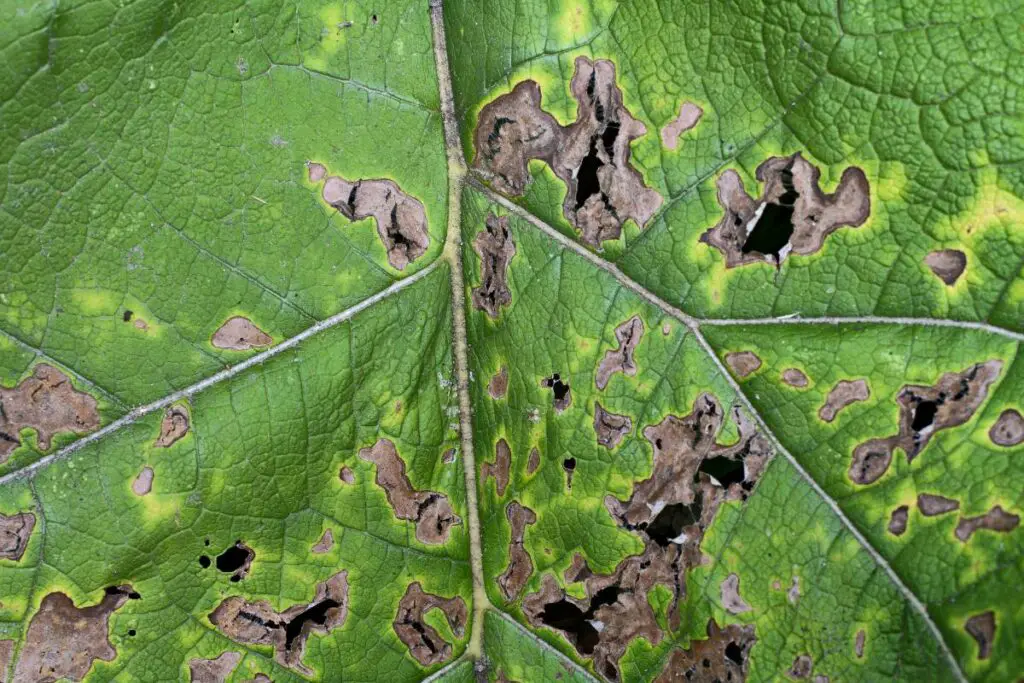
There are several scenarios when it comes to wilting:
- The entire plant is wilting
- Half part of the plant is wilting
- A few leaves are wilting
Wilting is a generic sign of various issues.
Underwatering
While the Zucchinis love warm weather, they are very thirsty.
Dehydration can make them wilt quickly.
A slight wilting during a heat wave is expected.
But excessive wilting indicates something else.
Check the soil moisture. If you feel the soil to be dry, consider soaking the soil with water very well.
Next, watering should be done when the top few inches have dried.
Add a layer of mulch. It can prevent evaporation of the moisture and trap it in the soil.
Sometimes, the soil is to blame.
Some soil types have poor retention qualities.
Adding enough compost with soil before planting can improve the retention.
Pest infestation
A bug called squash vine borer is the reason for this, mainly when no other signs of damage exist.
These borers can burrow into the plant stems.
Take one wilted stem and cut it open.
You will find white worms inside them.
The adults resemble wasps in red and black.
Check the plant base, and you can see yellow dust.
It is their droppings from the burrowing called Frass.
Prevent them by spreading some diatomaceous earth at the base of your plant. Reapply after rain or watering.
Use insecticides if you find too many adults at the plant base.
Bacterial wilt
When the entire plant is wilting suddenly, bacterial wilt is to blame.
One day, you will see that the plant is fine; the next day, you will see a sudden wilt.
Sometimes, the plant looks fine in the morning but wilts in the evening.
When bacterial wilt occurs, it becomes tough to revive.
The disease cannot be cured, and eventually, the plant dies.
Before they wilt, the leaves will turn yellow, then brown, and ultimately wilt.
Keep your plant healthy and try growing disease-resistant varieties to prevent the disease.
Keep an eye on cucumber beetles; they can spread the disease.
To prevent spreading, isolate the infected plant.
14. Stunted Growth
Once the Zucchini starts growing, it will grow rapidly.
Even the fruit size increases overnight.
Slow or stunted growth indicates a problem, for example, infertile soil or competition for resources.
Soil fertility
Zucchinis love well-drained, fertile soil.
That is why we mix organic matter and some fertilizers (I use 1-2 handfuls of chicken pellets) with the soil before planting or sowing seeds.
If you have not done this, your plant will not have any progress in its growth.
It will either have stunted growth or grow very slowly.
Also, ensure that the soil pH remains within 6.5 to 7.0. Do not add too much nitrogen to the soil.
Nutrient deficiencies
Even when you add organic matter to the soil before planting the Zucchinis, you must fertilize them once they enter the vegetative growth.
Over time, the nutrients deplete with daily watering.
Without fertilization, the plant will not improve its growth properly or grow many flowers and fruits.
At a time, you will witness stunted growth.
To fix this, start fertilizing your plant. Use a balanced liquid fertilizer with NPK 10-10-10.
Fertilize them once they grow 6-8 inches tall and grow leaves and vines.
Competition for resources
Another thing to consider is competition for resources.
It happens when there are a lot of weeds or companions with the exact requirements.
Weeds can compete and take away all the moisture and nutrients you apply to the soil.
As a result, the Zucchini will struggle to develop.
Remove the weeds from around the plant.
Apply mulch to suppress their growth.
The same applies to wrong companions.
Squashes, other cucurbits, potatoes, fennel, eggplant, and brassicas share the same resources.
These should not be planted near the Zucchinis.
While growing companions, consider the plants that will benefit Zucchini and vice versa.
For detailed information, you can review our article about the Best and Worst Zucchini Companions.
15. Fruits Rotting At The End (Blossom End Rot)
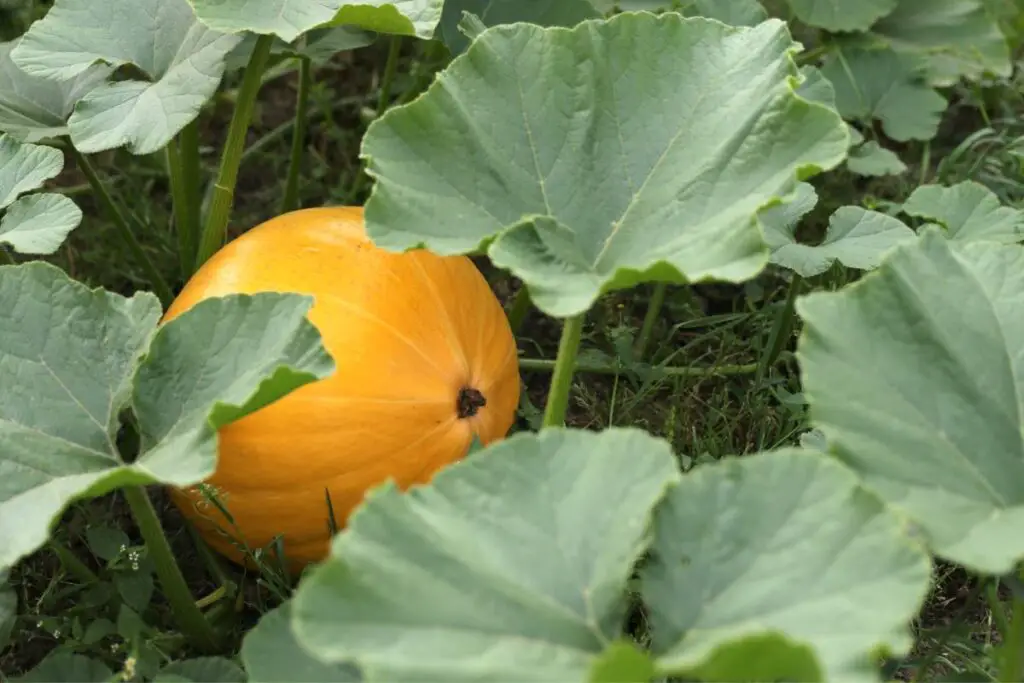
Zucchini will have a disease called Blossom End Rot, where the fruit rots at the end.
It also happens with eggplants and tomatoes.
The reason is calcium deficiency caused by inconsistent moisture levels or infertile soil.
You should use a well-balanced fertilizer for the Zucchinis.
A liquid fertilizer with 10-10-10 NPK should work.
Keep the soil evenly moist throughout the growing season.
It should neither be too dry nor too wet with heavy water.
Everything should be consistent.
Once the disease sets in, it is impossible to fix it.
You have to grow new plants in nutrient-rich soil if you have enough growing season left.
16. Environmental stresses
Both cold and hot weather can hurt Zucchini plants.
Since Zucchinis are summer squashes, they cannot tolerate cold weather.
The least they can endure is 50°F. Below this, the plant will start suffering.
Common signs of cold damage are:
- Wilted and brown leaves
- Leaves covered by gray mold
- Flowers falling off
- Less fruit production
- Plants dying
Similar things happen when the temperature exceeds 100-115°F.
The ideal temperature range for the Zucchini is 70-95°F.
The least Zucchini can tolerate is 115°F, but the plant degrades at 100°F. Signs of heat stress include:
- Wilted leaves and stems
- Leaves browning and curling at the tips and edges, indicating sunburns
- Dry and hard soil
- Fruits losing color and tasting bitter
- To protect the plant from cold weather:
- Use frost blankets or row covers to cover the plant when the night temperature crosses 50°F. Open the cover in the morning for sunlight.
- Add a thick layer of mulch to trap the moisture and heat in the soil.
- Grow cold-tolerant variants that can tolerate temperatures up to 32°F, for example, Raven, Costata Romanesco, Long Green Zucchini, and Fordhook.
- Grow early maturers. Colder zones have a shorter growing season. Ideal cultivars for such zones would be Sunglo, Eight Balls, Seneca, Green Machine, and Spineless Beauty.
- Take your plants inside if they are in pots.
- To protect the Zucchini from extreme weather conditions:
- Increase watering and maintain consistently moist soil.
- Use shading clothes or structures to prevent direct sunlight and encourage partial sunlight during the hottest time of the day throughout summer.
- Add a thick layer of mulch to keep the moisture trapped in the soil. It will maintain and reduce frequent watering.
- Grow heat-tolerant varieties like Dunja, Emerald Delight, Aehobak, Spineless Perfection, Desert, and Golden Glory.
17. Harvesting Mistakes
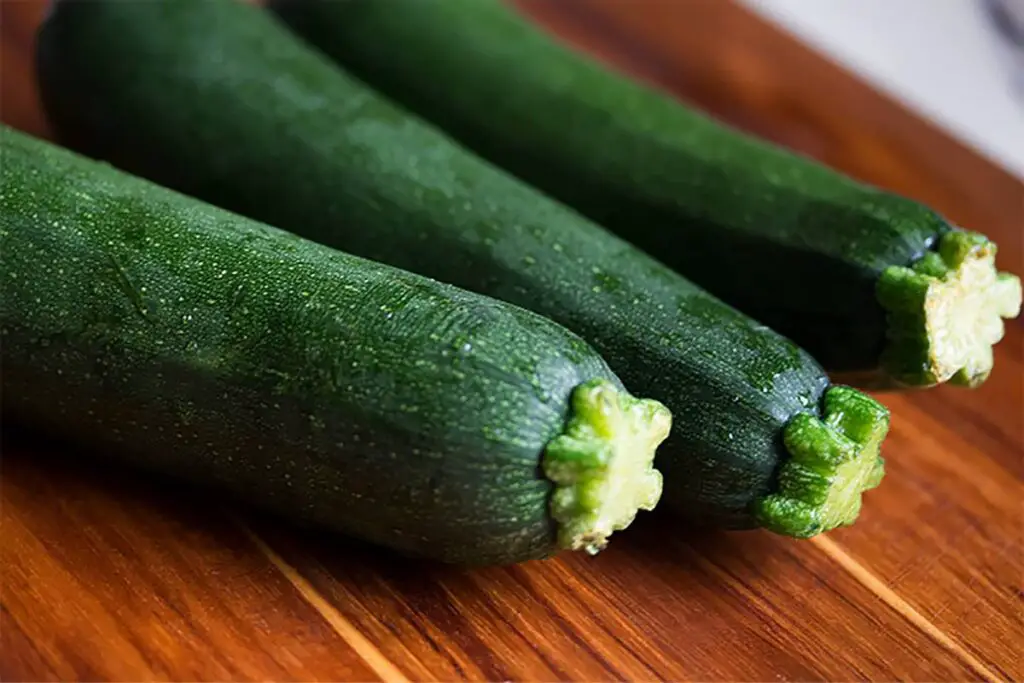
Harvesting mistakes include harvesting too early, late, or incorrectly.
While early harvesting is fine, picking them too early is not profitable.
You won’t be able to enjoy those unripe Zucchinis.
They won’t have a strong flavor and will be hard to eat.
You have to ripen them off the vine, provided the weather is warm.
Similarly, Zucchinis, harvested late, will also give you a poor taste.
It will be tough and bitter to taste.
It is easy to miss a harvest, especially in warmer regions.
Zucchini can grow and mature very fast if they constantly receive warm weather.
Zucchinis are best enjoyed when they have started ripening, are tender, young, and yet to fully mature.
Pick them when they are 6-8 inches long and 2 inches in diameter.
While picking, remember to leave a 1-inch stem on the fruit.
It will prevent the fruit from rotting.
You can snap it from the plant or use a knife. I prefer a knife.
Twisting the fruit while picking can harm the fruit and lead to rotting afterward.
Final thoughts
If you have been into gardening for a long time, you will likely encounter the above problems one day. But do not stress out and panic. These are part of the process; several troubleshooting steps exist to treat your plant and bring it back to normal.
There are several issues for several causes. All you need to do is find and fix the actual one. Sometimes, one issue could be the result of different problems. In that case, try troubleshooting each method and rule them out individually.
Keep caring for your plant with regular watering and feeding. Please provide enough sunlight, plant them in well-drained fertile soil, and protect them from extreme temperatures. Harvest them at the right time to enjoy their strong and sweet flavor and taste.
What is the best location to grow Zucchini outside?
It depends on where you live. In most cases, they grow best in the south and west-facing walls for adequate sunlight. During extreme heat, you can put up shading clothes and increase watering.
How can I save my Zucchini from environmental stresses?
Some issues like extreme weather conditions, rains, and winds cannot be controlled. In that case, you have to protect your plant. Avoid planting them in exposed areas, and put up frost covers, shading clothes, and other protection to save them from environmental problems.
Reference: Zucchini Wikipedia

